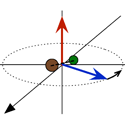A new phase for molecular superfluidity
Mastering control of ultracold atoms and molecules has allowed researchers the hope of studying a variety of exotic quantum phases. One example is the search for different kinds of superfluid behavior in ultracold diatomic molecular gases. However, simple cooling, as with liquid helium or superconducting materials, won’t do. For example, alkali molecules such as KRb tend to undergo chemical rearrangements into K2 and Rb2 at the desired experimental densities. A way around this is to establish interactions between atoms restricted to two dimensions, which simultaneously block chemical reactions and allow a topological form of superfluid pairing at high density. In a thorough theoretical analysis published in Physical Review A, Jesper Levinsen at the University of Cambridge, UK, and colleagues show how this might be accomplished.
Levinsen et al. consider a pairing interaction with the ungainly name “ px+ipy” that is known from studies of the fractional quantum Hall effect, among others. By applying a microwave field, the interaction potential between two molecules can be tailored to be attractive at long range and repulsive at short range (which avoids the chemical difficulties). This sets up conditions to establish the px+ipy superfluid phase, which refers to how the energy gap of the condensate varies on the Fermi surface (e.g., s wave is isotropic). This phase is expected to support Majorana modes which, if experimentally tractable, could form the basis of new kinds of quantum information processing in which qubits are topologically insulated from environmental disturbances. – David Voss





